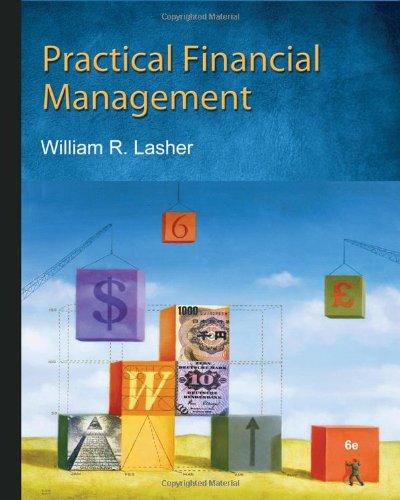Question
A stock has an expected return of 6%. What is its beta? Assume the risk-free rate is 8% and the expected rate of return on
A stock has an expected return of 6%. What is its beta? Assume the risk-free rate is 8% and the expected rate of return on the market is 18%.(Negative value should be indicated by a minus sign. Round your answer to 2 decimal places.)
Beta?
Based on current dividend yields and expected capital gains, the expected rates of return on portfoliosAandBare 11% and 14%, respectively. The beta ofAis .8 while that ofBis 1.5. The T-bill rate is currently 6%, while the expected rate of return of the S&P 500 Index is 12%. The standard deviation of portfolioAis 10% annually, while that ofBis 31%, and that of the index is 20%.
a-1.Calculate the the return predicted by CAPM for a portfolio with a beta of 0.8.(Round your answer to 1 decimal place.)
Return?%
a-2.Calculate the the return predicted by CAPM for a portfolio with a beta of 1.5.
Return?%
b.If instead you could invest only in bills and one of these portfolios, which would you choose?
PortfolioA or PortfolioB?
Assume a market index represents the common factor and all stocks in the economy have a beta of 1. Firm-specific returns all have a standard deviation of 30%.
Suppose an analyst studies 20 stocks and finds that one-half have an alpha of 3%, and one-half have an alpha of ?3%. The analyst then buys $1 million of an equally weighted portfolio of the positive-alpha stocks and sells short $1 million of an equally weighted portfolio of the negative-alpha stocks.
a.What is the expected return (in dollars), and what is the standard deviation of the analyst?s profit?(Enter your answers in dollars not in millions. Round your answers to the nearest dollar amount.)
Expected return$ ?
Standard deviation$?
b-1.How does your answer change if the analyst examines 50 stocks instead of 20?(Enter your answer in dollars not in millions. Round your answer to the nearest dollar amount.)
Standard deviation$?
b-2.How does your answer change if the analyst examines 100 stocks instead of 20?(Enter your answer in dollars not in millions.)
Standard deviation$?
Consider the following table, which gives a security analyst's expected return on two stocks for two particular market returns:
Market ReturnAggressive StockDefensive Stock7%2.7%4.5%142910
a.What are the betas of the two stocks?(Round your answers to 2 decimal places.)
BetaA ?
BetaD?
b.What is the expected rate of return on each stock if the market return is equally likely to be 7% or 14%?(Round your answers to 2 decimal places.)
Rate of return onA?%
Rate of return onD?%
c.If the T-bill rate is 8%, and the market return is equally likely to be 7% or 14%, what are the alphas of the two stocks?(Negative values should be indicated by a minus sign. Do not round intermediate calculations. Round your answers to 2 decimal places.)
AlphaA?%
AlphaD?%
Solve for question marks



Step by Step Solution
There are 3 Steps involved in it
Step: 1

Get Instant Access to Expert-Tailored Solutions
See step-by-step solutions with expert insights and AI powered tools for academic success
Step: 2

Step: 3

Ace Your Homework with AI
Get the answers you need in no time with our AI-driven, step-by-step assistance
Get Started


